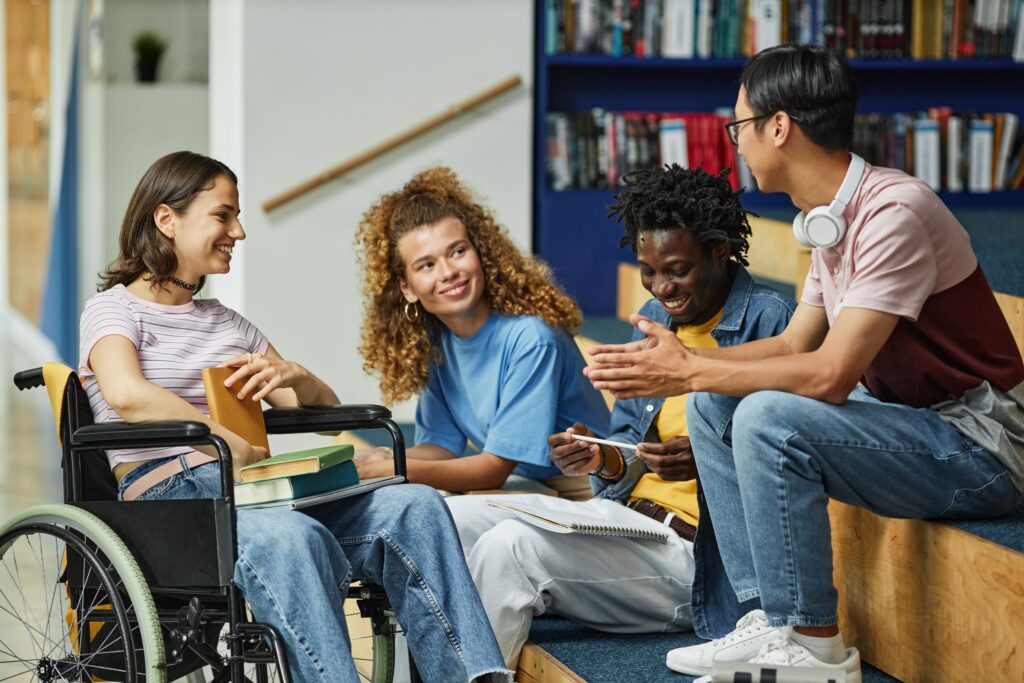About to move to Australia? Congratulations! You’ve taken the first step towards an exciting journey filled with friendships, countless professional opportunities and the chance to build life-long skills.
The thought of moving to Australia should be one filled with excitement, curiosity and anticipation. However, if you’re a student with a disability, it’s perfectly valid to be concerned about how you will be supported in your daily activities.
It may be a bit scary when you start organising your move, but this guide will give you everything you need to prepare for your adventure in the land Down Under.
Stage 1: Before you arrive in Australia
Is there government support for international students with a disability in Australia?
The Australian Government is committed to ensuring that all students are treated equally and given equal opportunities to live, be employed, and participate in the classroom. The Disability and Discrimination Act 1992 and Disability Standards for Education 2005 legislation have specified how education providers should offer support services to prevent discrimination against students with disabilities.
Tertiary education providers are expected to deliver an equally accessible learning environment. It is unlawful for them to deny support or services to a student who needs to access particular services, or charge an additional fee when providing accommodation facilities.
Is there university support for international students with a disability in Australia?
All tertiary education providers in Australia, including universities, have a student support office with a dedicated disability support advisor. The advisor’s role includes overseeing any disability adjustments that need to be made, as well as looking after the emotional needs of students at the educational institution.
To get started with your chosen education provider, you will first need to be registered with their disability support service. Registering to receive support from your educational institution before your classes start will give you plenty of time to evaluate what technical and academic adjustments you will need to succeed in your course.
The disability support advisor may put into place any of the following adjustments, depending on your needs:
Infrastructure adjustments: If you require infrastructure adjustments such as an accessible pathway for wheelchair access to your classrooms or devices to support your hearing implants, these adjustments will allow the education provider to install or plan the necessary infrastructure.
Academic adjustments: If your disability affects your capacity to learn and participate in your studies, these adjustments allow flexibility in completing your course or within the curriculum to suit your needs.
Technical adjustments: If your disability affects your time management ability, these adjustments prevent you from being disadvantaged by allowing you additional time when submitting assignments or completing exams.
Pro tip: Some standard adjustments include, but are not limited to, note-taking support, service animals, access to lecture recordings, use of laptops to complete exams, extra time for you to complete classwork and/or exams.
Stage 2: Studying and living in Australia
Moving to Australia is an exciting opportunity. But, there’s a lot to be aware of before you make the big move.
How do you register your disability?
To register your disability with your educational institution and to receive disability support, you will likely need a doctor’s certificate – either from your home country or obtained in Australia – outlining your disability and its impact on your capacity to participate in a learning or social environment.
Adjustments to infrastructure can be made upon confirmation of your enrolment at the educational institution. This will allow you to easily access the campus during your first week of studies. Academic and technical adjustments can be made in your first week once you’ve learned about the different support services offered by your education provider.
Know that the process of registering your disability and receiving adjustments is entirely confidential. Your situation will not be disclosed to anyone by the disability advisor, unless requested by you.
You’ve registered to receive support. What’s next?
Getting around an accessible campus: Physical movement is critical for students with some disabilities, as it allows you to access classrooms and social venues freely. Most campuses across Australia have extensive routes or physically accessible paths, such as elevators and ramps, to help students move around.
To learn how to get around your campus, you can ask your disability advisor (or O-week or future students’ team) to send you a copy of the map detailing accessible pathways. Alternatively, this map might be available on your education provider’s website.
Pro tip: You might want to take a picture of this map and have it stored in your phone so it’s easily accessible!
Finding accessible accommodation with a disability: Your education provider should have a list of accessible accommodation options available on campus, or details of other providers in your city.
Before choosing a long-term accommodation provider, you can look up accessibility information on different providers’ websites and compare your options.
If you’re ever unsure or have any questions, your disability support advisor can definitely help you out!
Stage 3: You’ve settled in – time to move around your city!
Accessible public bathrooms
You’re out in the city, enjoying the sun, and you need to go to the bathroom! Fear not. You can find the closest accessible bathroom or public amenities here. You can also look up accessible cafes and pubs around you.
Finding accommodating gyms
It can be hard to find gyms or fitness centres that support the physical wellbeing of a person with a disability. We recommend asking your disability advisor for a list of accessible gyms in your city or on campus.
You can also get started at home and work on your fitness journey using resources from Disability Sports Australia.
Using public transport with a disability
While accessing world-class education is one of the main reasons you moved to Australia, witnessing the country’s beauty is an important part of your experience. To help people move around, the Australian Government is working towards making all public transport ‘fully accessible‘ for people with disabilities.
On 20 March 2024, the Australian Government announced that it is reforming the Transport Standards. These updates aim to make public transport more accessible for people with disabilities and to prevent discrimination. The government worked with individuals with disabilities, public transport providers and state and territory governments to shape these changes.
More details on the specific areas of reform and a summary of the public consultations can be found on the Reform of the Transport Standards page. Reform of the Transport Standards page.
You can find accessible public transport across different states:
Congratulations! You’re now all set to make the most of your journey in Australia. While navigating your way around with a disability may seem scary, there are several support systems available to help you feel included in the community.





